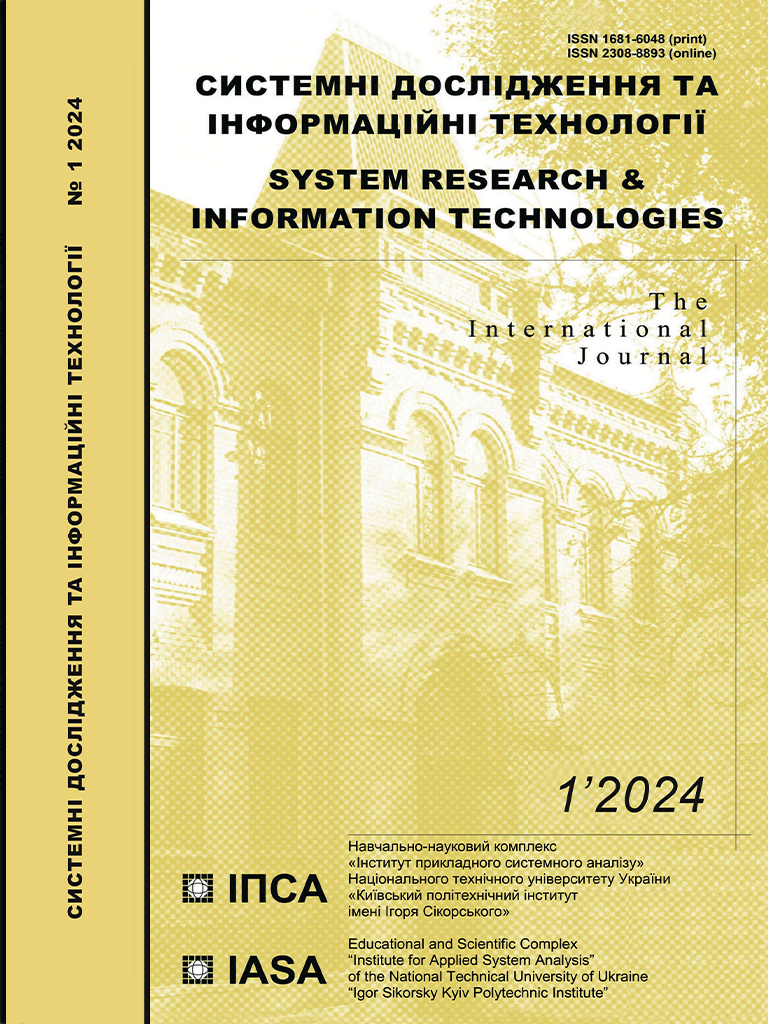Hybrid system of computational intelligence based on bagging and group method of data handling
DOI:
https://doi.org/10.20535/SRIT.2308-8893.2024.1.06Keywords:
hybrid system, bagging, hybrid GMDH-neo-fuzzy network, ARIMA, short- and middle-term forecastingAbstract
The paper considers the problem of short- and middle-term forecasting in the financial sphere. To solve this problem, a hybrid system of computational intelligence based on the group method of data handling (GMDH) and bagging, as well as an algorithm for its training, is proposed. The odd stacks of the hybrid system are formed by ensembles of parallel connected subsystems. ARIMA and the GMDH-neo-fuzzy hybrid network were chosen as such subsystems. The proposed system does not require a large training data set, automatically determines the number of stacks during training, and provides online operation. The experimental investigations were conducted using the proposed hybrid system, as well as separately using ARIMA and GMDH-neo-fuzzy. The accuracy of the predictions obtained is compared, based on which the feasibility of using the proposed hybrid system is substantiated.
References
G. Cybenko, “Approximation by superpositions of a sigmoidal function,” Mathematics of Control, Signals and Systems, vol. 2, pp. 303–314, 1989.
L.K. Hansen, P. Salomon, “Neural network ensembles,” IEEE Trans. on Pattern Analysis and Machine Intelligence, vol. 12, pp. 993–1000,1990.
Ye. Bodyanskiy, I. Pliss, “Adaptive generalized forecasting of multivariate stochastic signals,” Proc. Latvian Sign. Proc. Int. Conf. Riga, vol. 2, pp. 80–83, 1990.
Ye.V. Bodyanskiy, I.A. Rudneva, “On one adaptive algorithm for detecting discords in random sequences,” Automation and Remote Control, 56, no. 10, pp. 1439–1443, 1995.
A.J.C. Sharkey, “On combining artificial neural nets,” Connect. Sci., vol. 8, pp. 299–313, 1996.
S. Hashem, “Optimal linear combination of neural networks,” Neural Networks, vol. 10, no. 4, pp. 599–614, 1997.
U. Naftaly, N. Intrator, and D. Horn, “Optimal ensemble averaging of neural networks,” Network: Comput. Neural Syst., vol. 8, pp. 283–296, 1997.
D.T. Pham, X. Liu, “Neural Networks for Identification,” Prediction and Control. London, Springer Verlag, 1995, 238 p.
L. Breiman, Bagging Predictors. Techn. Report No. 421. Dept. of Statistics, Univ. of California, Berkeley, CA 94720, 1994, 19 p.
A.G. Ivakhnenko, V.G. Lapa, Cybernetic forecasting devices. K.: “Naukova Dumka”, 1965, 216 p.
A.G. Ivakhnenko, G.A. Ivakhnenko, and J.A. Mueller, “Self-organization of the neural networks with active neurons,” Pattern Recognition and Image Analysis, 4(2), pp. 177–188, 1994.
J. Schmidhuber, “Deep learning in neural networks: An overview,” Neural Networks, vol. 61, pp. 85–117, 2015.
Yuriy Zaychenko, Yevgeniy Bodyanskiy, Oleksii Tyshchenko, Olena Boiko, and Galib Hamidov, “Hybrid GMDH-neuro-fuzzy system and its training scheme,” Int. Journal Information Theories and Applications, vol. 24, no. 2, pp. 156–172, 2018.
Yuriy Zaychenko, Yevgeniy Bodyanskiy, Olena Boiko, and Galib Hamidov, “Evolving Hybrid GMDH NeuroFuzzy Network and Its Application,” International Conference IEEE-SAIC 2018, Kyiv, IASA, 8–11 October, 2018.
Yevgeniy Bodyanskiy, Nonna Kulishova, Yuriy Zaychenko, and Galib Hamidov, “Spline-Orthogonal Extended Neo-Fuzzy Neuron,” International conference CISP- BMEI 2019.
Yevgeniy Bodyanskiy, Yuriy Zaychenko, Olena Boiko, Galib Hamidov, and Anna Zelikman, “The Hybrid GMDH-Neo-fuzzy Neural Network in Forecasting Problems in Financial Sphere,” Intern. Conference IEEE SAIC 2020 in book “Advances in Intelligent Computing”, Springer, 2020, vol. 1075, pp. 221–225.
Ye. Bodyanskiy, O. Vynokurova, and I. Pliss, “Hybrid GMDH-neural network of computational intelligence,” Proc. 3rd Int. Workshop on Inductive Modeling, Krynica, Poland, 2009, pp. 100–107.

